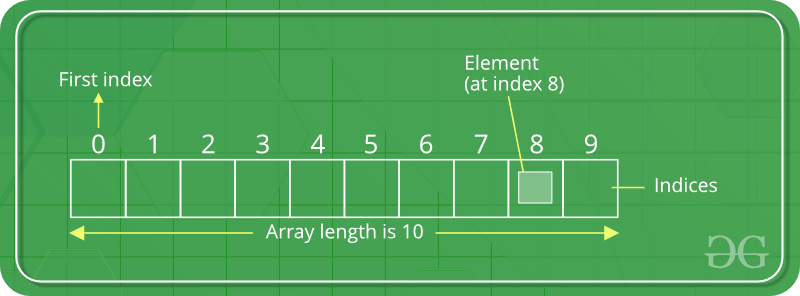In Dart programming, List data type is similar to arrays in other programming languages. List is used to representing a collection of objects. It is an ordered group of objects. The core libraries in Dart are responsible for the existence of the List class, its creation, and manipulation.
Logical Representation of List

The index of the element represents the position of the specific data and when the list item of that index is called the element is displayed. Generally, the list item is called from its index.
Types of List
There are broadly two types of lists on the basis of their length:
- Fixed Length List
- Growable List
Fixed Length List
Here, the size of the list is declared initially and can’t be changed during runtime.
Syntax:
List ? list_Name = List.filled(number of elements, E, growanle:boolean);
Example:
Dart
void main()
{
List? gfg = List.filled(5, null, growable: false);
gfg[0] = 'Geeks';
gfg[1] = 'For';
gfg[2] = 'Geeks';
print(gfg);
print(gfg[2]);
}
|
Output:
[Geeks, For, Geeks, null, null]
Geeks
Growable List
This type of list is declared without declaring the size of the list. Its length can be changed during runtime.
Adding a value to the growable list:
Dart
void main()
{
var gfg = [ 'Geeks', 'For' ];
print(gfg);
gfg.add('Geeks');
print(gfg);
}
|
Output:
[Geeks, For]
[Geeks, For, Geeks]
Adding multiple values to the growable list:
Dart
void main()
{
var gfg = [ 'Geeks' ];
print(gfg);
gfg.addAll([ 'For', 'Geeks' ]);
print(gfg);
}
|
Output:
[Geeks]
[Geeks, For, Geeks]
Adding a value to the growable list at a specific index:
Dart
void main()
{
var gfg = [ 'Geeks', 'Geeks' ];
print(gfg);
gfg.insert(1, 'For');
print(gfg);
}
|
Output:
[Geeks, Geeks]
[Geeks, For, Geeks]
Adding multiple values to the growable list at specific indexes:
Dart
void main()
{
var gfg = [ 'Geeks' ];
print(gfg);
gfg.insertAll(1, [ 'For', 'Geeks' ]);
print(gfg);
print(gfg[1]);
}
|
Output:
[Geeks]
[Geeks, For, Geeks]
For
Types of List (Basis of its Dimensions)
There are various numbers on the list based on dimension, but the most popular among them are:
- 1-Dimensional (1-D) List
- 2-Dimensional (2-D) List
- 3-Dimensional (3-D) List
- Multidimensional List
Here, we have already discussed the 1-D list.
2-Dimensional (2-D) List
Here, the list is defined in two dimensions and thus forming the look of the table.
Creating 2-D List:
Dart
void main()
{
int a = 3;
int b = 3;
var gfg = List.generate(a, (i) = > List(b), growable: false);
print(gfg);
for (int i = 0; i < 3; ++i) {
for (int j = 0; j < 3; ++j) {
gfg[i][j] = i + j;
}
}
print(gfg);
}
|
Output:
[[null, null, null], [null, null, null], [null, null, null]]
[[0, 1, 2], [1, 2, 3], [2, 3, 4]]
Another way of creating a 2-D List:
Dart
void main()
{
var gfg = List.generate(3, (i) = > List.generate(3, (j) = > i + j));
print(gfg);
}
|
Output:
[[0, 1, 2], [1, 2, 3], [2, 3, 4]]
There is also another way of creating a 2-D list, i.e giving the values associated with the indexes and it will lead to the creation of the 2-D list.
3-Dimensional (3-D) List
The representation of a 3-D list is quite difficult but its creation is similar to that of a 2-D list.
Example:
Dart
void main()
{
var gfg = List.generate(3, (i) = > List.generate(3,
(j) = > List.generate(3,
(k) = > i + j + k)));
print(gfg);
}
|
Output:
[[[0, 1, 2], [1, 2, 3], [2, 3, 4]], [[1, 2, 3], [2, 3, 4], [3, 4, 5]], [[2, 3, 4], [3, 4, 5], [4, 5, 6]]]
Note: In a similar fashion one can create an n-dimensional List i.e by using the “List.generate()” method.
Like Article
Suggest improvement
Share your thoughts in the comments
Please Login to comment...